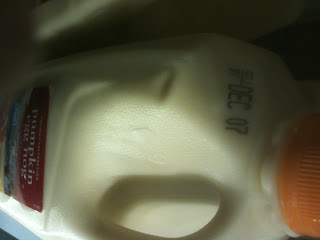Got the basis of this recipe from
Kelsey Nixon's show on the Cooking Channel. It looked fascinating and easier than some of the other things I've been planning on trying, so...next on the list it got to be.
You can look up the original recipe (and you should) at the link above. I'll just present the modified version I tried.
1 lb Italian sausage
12 oz package of diced celery and white onion
1 cup of pomegranate arils
4 large eggs, beaten
6 pieces prosciutto
10 oz package of dry stuffing/bread cubes
1 t fennel
1 t dried thyme
2 c juice from a turducken (cooked, of course--how else would you get any water out? Don't tell me.)
I didn't particularly plan it out. I saw that fennel sausage was the first thing listed in Kelsey Nixon's recipe and couldn't find any so I thought I was being clever when I opted for Italian sausage and added fennel instead of fennel sausage and various other spices, and was feeling smugly clever until I just now noticed that Italian sausage was also called out in the original recipe. Well, there was plenty of meat as is; it may have been more like a meatball than stuffing, in my book, if I'd doubled the amount of sausage.
I can't believe I just said "there was plenty of meat as is."
Since I was low on prosciutto I ended up just doing one slice per muffin tin cup and filling a small breadpan with the rest of the stuffing, but it was fine since I still needed something to go with that turducken.
It turned out pretty well, too, although I made the mistake of trying to eat it while watching "Eraserhead" and I just had to stop. But we're getting ahead of ourselves; I was barely able to get the prosciutto out of the package without tearing it apart, so I ended up breaking each slice in half and trying to work with two rough square of ham tissue, which was a bit easier. I had foreseen the possibility of this working better, but I sadly failed to honor this prophecy in my own mind.
The arils were just serendipity. I hadn't read much past the ingredient list when I was shopping so I was half inclined to get fresh cranberries if I could find any, thinking about how the balance against Granny Smith apples would change if I did, when I just saw the package of fresh arils. Also, they were on sale, and I didn't remember the apples until I was leaving the parking lot Meh; world didn't end without them.
I admit, I've been going the slightly processed/prepackaged route here and there, but when I'm trying to discern something new, I try to weigh convenience allowing me to focus on the novel aspects of a dish against the superior quality of ingredients prepared freshly and properly by me in the kitchen. In this case the sacrifice seemed negligible; in other cases, it's usually because I can't even find the best stuff fresh.
On with the cooking! As I would presume, you turned your oven on to 325°F back when I was talking about David Lynch's ouvre killing my appetite. If not, there's plenty of time while the sausage is browning over medium to medium-high heat in a skillet.
When the meat was browned, I added the celery/onion mixture and a little under half the arils. When they started to cook down, I started adding the spices and half the juice (I had just pulled the turducken out of my slow cooker and the bag it was in still had all its juices). I think I over did the juice a bit, and feared it might not have had as rich a flavor of legitimate chicken stock, so I let it reduce by approximately half before transferring it to a large bowl with the dry stuffing. Meanwhile, I used the rest of the poultry juice--ugh, it sounds awful phrased this way, doesn't it?--to deglaze the skillet and allow the sausage-bread mixture to cool before adding the eggs and the remainder of the arils.
Oh, I threw in a little red-black pepper mix just before taking the sausage off heat, too, because I couldn't find a jar of black pepper. Worked fine.

All that being done, I scooped as much of the mixture into the prosciutto-lined muffin tin as I dared and packed the rest into a 7"x3" breadpan. Into the oven for 20 minutes, then check for doneness.
It looks pretty much like this when it comes out, only the meat is visibly crispy and everything else is slightly darker on top. I remembered to take a "before" picture but not an "after" one, sorry.
It's not a stuffing recipe like what I normally use, but it was quite good. The pomegranate's sweet tartness worked with the savory meat just as well as I could have hoped. It was just a bit crumbly around the edges, but nothing that shouldn't be resolvable by a plate. Maybe that second pack of sausage would have turned it into a less frangible fluffy meatball like you get in some restaurants, but whatever.
Some variations to consider for the future: bacon instead of prosciutto, and mini-muffin tins, which would have been more accommodating to my half slices of prosciutto.
UPDATE--The photos should be visible in the published posting of this recipe now, not just in the draft preview that only I can see. What would have been the good of that? I was in the room with them at the time; it's not like I need to prove that to anybody.


